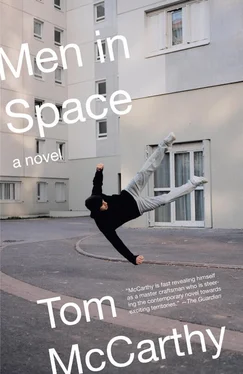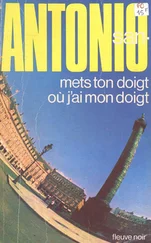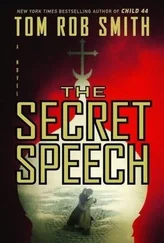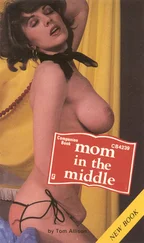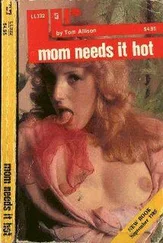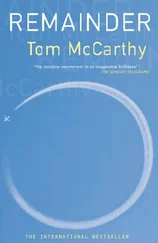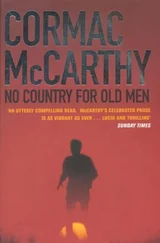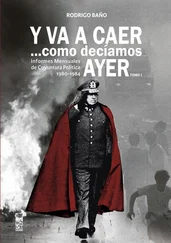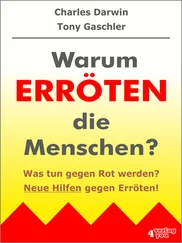Enough talk of icons! Do you know who I bumped into? Tyrone! Yes, Tyrone the black tran who compères at the Roxy when he’s in Amsterdam. He’s got the Czechs convinced that he’s some high-powered theatrical director back in San Francisco, and they’ve flung their doors wide open to him. Their legs too: he seems to have the pick of Prague’s young gayboys clinging to his shawls. I met him with Martin in some club and he invited me to come to another club on New Year’s Eve to watch him performing one of his cranked-up cabaret numbers with a bunch of Czech extras. He said Flash Art or Art in Europe or someone would be covering it, but I’m not sure that that wasn’t just the usual Tyrone hype. I don’t think I’ll go. He was quite zonked, as usual — and he handed me a replica gun, which I then went and left, it’s just occurred to me, at Maňásek’s. A shame: I wanted to paint it blue and give it to you as a homage to your hero Mondrian . Tant pis.
OK, I’ll run and post this overlong epistle. Should you desire to respond in kind, you just have time before I leave for Tallinn. Did you pay the phone bill? If not, please please do. Typeset the Harris catalogue? Ditto. Can’t wait to be with you corporeally as I am now in spirit. Stay lovely, halo boy .
J .
xxxxxxx
* * * * *
The first stage, after the boards have been gessoed and gilded and the drawings transferred onto these, is painting the background colours. On the day after Christmas Day, Ivan Maňásek lays out the materials he’ll be using. His pigments he arranges in two rows, ranging from light to dark, from zinc white on the upper row’s far left to lamp black on the lower row’s far right. The brushes he stands hair-up in a jar beside the phials. He’s using fine best-sable riggers: two each of numbers zero, one and two, three each of numbers three through five and one each of eight through fifteen. He cracks an egg over a bowl, lets it run out onto his hand so that the white slips through the gaps between his fingers, leaving the yolk resting in his palm. Then, pinching the yolk between the thumb and first finger of his other hand, he lifts it up, suspends it above another, smaller bowl and pricks it with a needle so the orange liquid oozes from the skin, which he then throws away. To the decanted yolk he adds roughly nine times its own volume of purified water and three drops of vinegar. He stirs the solution, then transfers it to the compartments of two ice cube trays, to which he adds the pigments, one by one, by wetting a brush in the solution, dipping it into a phial, letting it pick up flakes, then plunging these back into the compartment. The Prussian blue, the terra verte and the raw and burnt siennas are gritty and need to be ground down against glass. It’s just like chopping up Hájek’s speed: he uses the same shaving mirror, hunched over it, watching his own face becoming eclipsed by these powdery tones …
To apply the background colours of the sky, the sea, the mountain and the saint, he uses petit lac , flooding paint onto the gessoed panels with well-loaded riggers, eight and up. As each wet load goes on it forms a puddle; the next load goes no more than a centimetre from the first one, the third similarly equidistant from the other two and so on; each one, forced by its volume to expand, eventually runs into its neighbours, all the puddles merging to form one large puddle or (whence the technique’s name) little lake. He’s already incised the boundaries of each area so that different colours won’t run into one another; all the same, he has to let each dry before starting the next. The sea, of course, is blue; the ships, light brown; the strange, multilayered building at the bottom, mainly black; the mountain, darker brown, with white streaks which he’ll add later. The sky’s silvery gold save for the part of it that’s taken up by the ellipse around the saint’s head: this is brilliantly, almost luminously golden — he’ll have to burnish the leaf afterwards. The saint’s robes are red. As he daubs the caput-mortum violet on, it strikes him that, even though he’s got the original to work from, he’ll have to bring the full-length mirror from his bedroom and dress in a sheet himself to get a real sense of how the body’s articulation points define folds and creases. To think that his corrupt flesh should be invading this image of piety makes him first laugh, then shiver — instinctively, for reasons that he doesn’t really understand.
Is it while he’s copying the robes that Sláva Kinček drops by? Hard to say. Time’s petit lac- ing too, mornings running into afternoons, days into nights. When he’s particularly tired, Ivan sleeps — but as his dreams consist entirely of saints, mirrors and mountains, of pools of colour flooding gessoed landscapes, he usually opts, after a short while, to wake up and encounter the material versions of these objects and events. It’s after he’s slipped the bedsheet on, in any case: Sláva spends several minutes laughing at him, then tells him to put some real clothes on and come out for a meal — he’ll pay, he’s found a place, a new place, really chic. When Ivan declines this invitation, Sláva huffs for a while and tells him that he and Michael could have the whole thing scanned, photoshopped and transferred back to wood in twenty minutes if he’d care to come round to their office on Italská. When Ivan doesn’t even bother answering, he huffs some more, then leaves, instructing Ivan to present himself at Pod Stalinem on New Year’s Eve for the greatest party of all time.
Ivan pays Klárá more attention when she calls round, but only because she gives him pointers. When he’s reinstating the drawings, dragging the zero- and one-riggers over the barely visible incised lines, he’s forgotten to modify the egg-to-water ratio in the base solution; she tells him one-to-six, then one-to-six for the lighting stage too, one-to-twelve for the nourishing layer, then one-to-three for skin pigments in the final highlights, then … He makes her write it down on a piece of paper which he sticks to the coffee table’s surface with the rabbit-skin glue. She also points out that he needs to model the saint’s face with a transparent glaze of raw umber mixed with a little terra verte, to deepen the shadow slightly. She asks him why he’s making two copies. He shrugs and asks her why she brought him two boards. She throws her hands up, goes and buys some food and brings it back to the atelier where it sits beside the table oxidizing, glazing like the hues of the original. She starts telling him he shouldn’t have accepted a commission like this without first seeing a provenance certificate, that he should be more careful who he gets involved with — and he zones out, loses himself in the contours of the two identical landscapes he’s creating, their brown-white mountains and blue seas.
After she’s gone, Ivan turns his attention to the saint’s hair. It’s about the same length as his, but grooved and greased back, almost plastic. He tries wetting his hair and combing it the same way, but it won’t stay grooved. Does Nick use hair gel? Nick’s been away almost constantly since — when? — must be since two days before Christmas, when he went over to that Gábina’s. How long ago is that now? Nick hasn’t even slept here as far as Ivan knows; he seems to recall him having slipped quietly in and out with some girl in tow. Perhaps he dreamt that, let Nick drift past the incised borders of his mind, entering elliptically. When was the last time he slept, in any case? Ivan goes to the bathroom and looks through the cupboard by the sink, but doesn’t find any hair gel. Then he remembers he’s got beeswax for the varnishing stage, goes into the kitchen, melts a little in a saucepan, trickles it onto his head and smoothes it evenly across. It works: his hair can now be moulded into the same rippled, slightly undulating layer as the saint’s — a single layer, as though one of several strata of a geological formation had been peeled away, shrunken, then folded round his scalp. As he copies the original’s hair onto both his paintings he moves his own head from side to side, watching in the mirror the way the light slips over yellow ochre, raw sienna, ivory black, glazing it with umbers. And if he opens his mouth just like this man’s opening his … It gets so that he can feel the saint’s way from the original on to the two new boards, channel the multiplication not just through his hands but through his entire body. His mind too: he lets his eyes glaze over so that the atelier’s reflection blurs, and pictures himself floating in the sky over an ocean, up above a mountain streaked with white, the world and its dark windows and its people and the lower areas of sky draining away from him like egg white through fingers as his own yolk is pinched upwards, elongating, waiting for the final, divine prick that will release it from its skin to let it mix with purified liquid, with the pigments that lie behind sky, earth, people, everything …
Читать дальше
